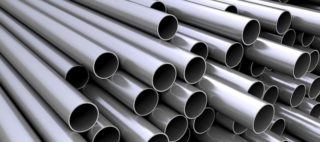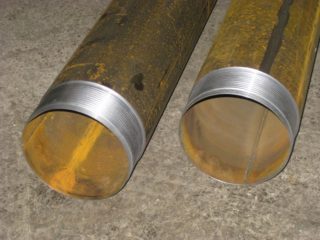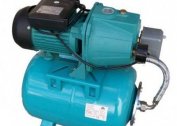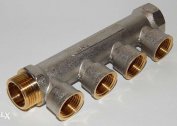Steel water pipes are predominantly installed in aggressive places of passage of the highway. Such designs are characterized by high strength and resistance to possible mechanical stress. However, such options are not suitable for domestic water supply, therefore, they focus only on industrial facilities.
Regulatory requirements
Despite the high popularity of PVC pipes, steel pipes are not inferior to them. Since engineering networks bring water to multi-apartment and private houses, they must comply with some standards of SNiP, which indicates the safety of these structures for humans.
- GOST 30732-2006. One of the main regulatory documents presented to steel plumbing structures. Such raw materials are usually used for laying the trunk in soil conditions. Products are suitable if the coolant has a constant temperature of no higher than 140 degrees. Short-term increases of t up to 150 degrees are also allowed.
- GOST 9567-75. This marking of the steel structure indicates that it is highly accurate. The product may be hot rolled or cold formed. Also, pipes of steel of this type are divided into galvanized and chrome.
- GOST 2591-2006 (88). The assortment indicates that the pipe is hot rolled. The design has a square or rectangular section with sides from 6 to 200 mm. Larger designs with a similar section are made exclusively to order.
The parameters of metal structures, which has a state standard, are always individual, therefore, before starting production work it is necessary to determine the dimensions of the future highway. The use of steel pipes is allowed in the case of the construction of pressure stations, water pipes in seismically unstable zones, for laying at the bottom of the ravine.
Types of Steel Pipes
As a rule, metal structures are classified by the manufacturing method, from where they take their individual name. For industrial and domestic purposes, the following options can be used:
- Cast. Rolled products are manufactured using pipe-casting machines. This type of manufacture is provided for exceptional purposes, since such designs are used in some industrial sectors.
- Seamless. Pipes are produced using pressed machines or specialized blanks. Typically, such options are not applicable to create a water supply system. They are more expensive and reliable for organizing highways of the chemical or oil industry.
- Welded (electrowelded). Rental is the most popular for water mains. Such products are made of steel strips, which are cut, and then bent under high temperature.
There are longitudinal pipes that are suitable exclusively for water supply. Such products have more than a hundred possible diameters.
Each design should correspond to its own indicator, depending on which it is divided into groups.
- Ordinary steel pipe. High strength metal construction. The price is too high, but this is justified by its characteristics. A wide selection of shutoff valves is allowed.
- Galvanized conduit. The steel structure has an inner and outer layer of zinc, which protects against the harmful effects of the environment. Such products are suitable even in conditions of risk of increased deformation.
- Corrugated piping.Stainless steel resists many chemical and mechanical effects. Often such hire is used in problem areas to avoid water leaks. A flexible pipe is usually installed on the taps in the arrangement of home water supply.
- VGP pipeline. It is made of special steel alloy. Usually, air pipelines are made from such rolled products, as they withstand changes in climatic conditions. The material is made of carbon steel.
Based on the type of pipeline chosen, it is necessary to buy connecting elements and other details. The main thing is that fittings in diameter are suitable for it.
Technical characteristics of steel pipes for water supply
The range varies from the minimum diameter to indicators with large dimensions. These two types are used for different purposes. The table of sizes of steel water pipes according to GOST will help determine the design option.
|
Conditional pass
|
Outside diameter
|
Wall thickness | Weight 1 m, kg | ||||
| lungs | ordinary | reinforced | lungs | ordinary | reinforced | ||
| 6 | 1,8 | 2 | 2,5 | 0,37 | 0,4 | 0,47 | |
| 8 | 2 | 2,2 | 2,8 | 0,57 | 0,61 | 0,74 | |
| 10 | 2 | 2,2 | 2,8 | 0,74 | 0,8 | 0,98 | |
| 15 | 2,35 | – | – | 1,1 | – | – | |
| 15 | 2,5 | 2,8 | 3,2 | 1,16 | 1,28 | 1,43 | |
| 20 | 2,8 | – | – | 1,42 | – | – | |
In addition to the dimensions (in inches or mm) and the mass of metal for the construction of the water supply system, it is also necessary to take into account the operational characteristics of the pipe. You can find out about this from the labeling or just ask the seller.
Features of connection and installation
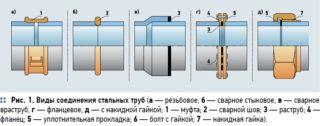 To make a structure, you must strictly follow the algorithm. A scheme is preliminarily created, and then the project is implemented on the ground. Under installation conditions, the type of environment in which the structure is made must be taken into account. Pipe connection options can be as follows:
To make a structure, you must strictly follow the algorithm. A scheme is preliminarily created, and then the project is implemented on the ground. Under installation conditions, the type of environment in which the structure is made must be taken into account. Pipe connection options can be as follows:
- using a weld;
- welding flanges to the ends of the nozzles;
- by welding with the formation of loops;
- by squeezing and chasing.
During installation, the engineer must responsibly approach the rules for the construction of main water pipelines, since they are usually used in an area with maximum pressure and high temperature. A gas pipeline should only become similar in this way if it is designed to run water through it.
Advantages and disadvantages
Steel pipes are considered one of the most durable. They are used in various conditions on the street, less often in domestic premises (apartment, house). The advantages include:
- long service life even in aggressive conditions;
- perform equally well when used for hot and cold water supply;
- the presence of protective material;
- the use of simple welding to create joints;
- compliance with all necessary state standards in accordance with SNiP.
Among the minuses should be highlighted the susceptibility to corrosion during improper operation of the finished structure. The presence of rust negatively affects the taste of drinking water, it is enriched with harmful metals. Rust tends to form on the outer walls of pipes and on the inside.
When using metal water pipes, there is a high risk of siltation of the lumen, as a result, a breakthrough is possible, and as a result, a replacement of the structure. Such a design is not to be cleaned, especially if the narrowing of the clearance occurred in its rotary part.
While in the ground or in any other conditions, steel pipe structures retain their attractive appearance even without painting.
Price per meter
Since steel structures differ and are classified according to different characteristics, the price per meter of metal pipes for water supply will vary. A simple rental with the usual cross section will cost several times less than corrugated. Popular Views:
- steel pipe "VGP" with a diameter of 50 mm - estimated cost up to 335 rubles .;
- steel pipe with a square cross section with sides 20x20 mm - price 100 rubles .;
- seamless steel pipe - cost 650 rubles;
- galvanized pipe with a circular cross section with a diameter of 20 mm - an approximate cost of 700 rubles.
Otherwise, all prices for engineering structures vary depending on the manufacturer's company and the region where they are sold.
